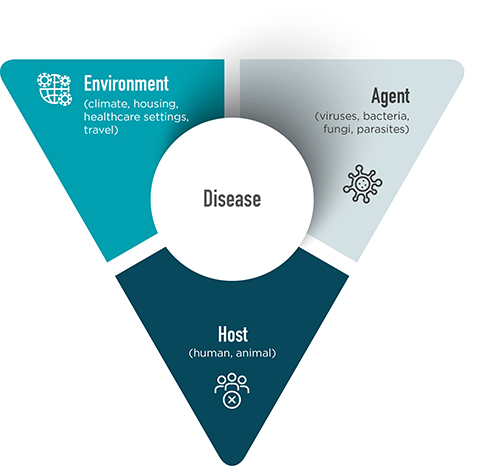Lately, people may have heard references to the term epidemiology. So, what exactly is that? According to the Merriam-Webster dictionary, epidemiology is “a branch of medical science that deals with the incidence, distribution, and control of disease in a population”. While doctors and clinicians deal with the effects of disease within a single person, i.e. they work one-on-one with patients to diagnose problems and determine what can be done to make them healthier, epidemiologists are concerned with how diseases affect society as a whole. They study groups of people to diagnose and respond to illnesses in populations: how many are affected (i.e. prevalence), who is affected and why (i.e. determinants of health), and what works and what doesn’t to cure or prevent these illnesses at a societal level (e.g. treatment protocols, public health interventions). Simply put, epidemiology is the basic science of public health.
In its early days, epidemiology concentrated on studying diseases such as cholera. Today, epidemiology is applied to all kinds of health-related conditions - diseases (e.g. influenza, cancer, depression), health problems (e.g. obesity, high blood pressure), injuries (e.g. work-related, traffic-related) and social problems (e.g. gambling, domestic violence). Its role is to describe who is affected by these conditions, why, and what can be done to treat and prevent them.
WHAT IS AN EPIDEMIOLOGIC TRIANGLE?
The Epidemiologic Triangle, sometimes referred to as the Epidemiologic Triad, is a tool that scientists use for addressing the three components that contribute to the spread of disease: an external agent, a susceptible host and an environment that brings the agent and host together. Since different diseases require different balances and interactions between these three factors, it’s critical to fully assess each component in order to develop effective control and prevention measures.

THE AGENT
The agent is the pathogen, including a virus, bacterium, parasite or other microbes. Usually, an agent’s presence can be enough to cause disease. However, a variety of factors can influence whether or not exposure to the agent will directly result in disease. That’s why it’s important to consider the other vertices on the Epidemiologic Triangle before making a final assessment.
THE HOST
The host is the organism who is exposed to and harbor a disease. Sometimes, the host may not show any signs of illness and could be unaware that they have the disease. Sets of risk factors, including age, gender, hygiene practices and genetic composition can influence a host’s susceptibility to an infectious agent. Typically, children, the elderly and people with compromised immune systems are more susceptible to becoming a host.
THE ENVIRONMENT
The last component in the Epidemiologic Triangle is the environment. This refers to any extrinsic factors that can influence exposure and susceptibility. Environmental factors may include physical aspects like climate, biologic aspects like animals transmitting agents, and socioeconomic factors like crowding or lack of sanitation.
HOW TO BREAK THE EPIDEMIOLOGIC TRIANGLE
To prevent the spread of disease, at least one side of the Epidemiologic Triangle must be broken. Some things you can do to break the Epidemiologic Triangle include:
- Follow proper hand hygiene at all times.
- Kill germs by disinfecting high-touch areas regularly.
- Clean and disinfect high-touch areas/items often.
If you need help preventing the spread of infection in your facility, call on the experts at ServiceMaster Clean. Our cleaning services use best practices and follow protocols designed by public health officials like Health Canada to help with infection control and prevention, risk reduction and environment improvement.
